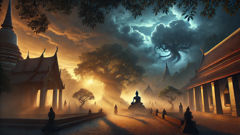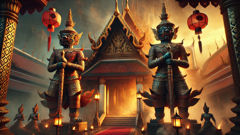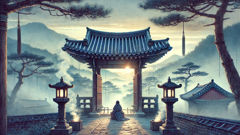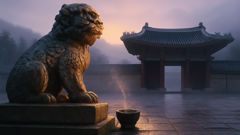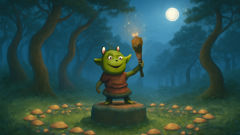Introduction
The air over the coastal savannah of Ghana thrums with memory and pride. Here, beneath the shade of ancient silk-cotton trees and along the golden curve of the Gulf of Guinea, history is alive in color, song, and ritual. Villages bustle with market women in swirling cloth, children’s laughter, and the boom of distant drums. But in the heart of every Fante town, where narrow lanes open into sunlit courtyards, there is a pulse that beats to a deeper, older rhythm—the call of the Asafo. To outsiders, Asafo might sound like the name of a distant place, but to the Fante-Akan people, it means “war company”—the living soul of their community. From the 17th century onward, as the Atlantic winds brought both opportunity and threat to Ghana’s shores, these warrior companies emerged as protectors, artists, and keepers of tradition. They paraded in dazzling ranks, each Asafo group marked by its own hand-painted flags—vivid banners that told stories of triumph, defiance, and unity. The flags alone are a language, crowded with symbols: crocodiles swallowing men whole, mighty swords, and hands raised in warning or blessing. To walk among the Asafo is to enter a living gallery of history and myth. But their legend goes deeper than art. When invaders threatened or quarrels rose between towns, the Asafo assembled in swift, disciplined force, their ranks guided by drummers and the wisdom of elders. They trained not only for war, but for ceremony—ritual dances, bold songs, and the annual “Akwanbo” festival when the whole village would turn out to honor ancestors and renew their vows of unity. The Asafo’s tale is one of courage—against colonial powers, against internal strife, and, most of all, against forgetting. Their banners still wave today, echoing with the same promise: that a people’s spirit can be guarded by those who love it most.
The Drums That Called the Brave
As dawn broke over Cape Coast, a chill breeze swept the low hills. The first rays of sunlight danced on the crimson and gold cloaks of the Asafo elders. In the compound of Company Five, the air shimmered with anticipation. Young men, faces streaked with clay and charcoal, gathered in silent lines. For weeks, rumor had snaked through the coastal towns—traders whispered of slave raiders inland, while fishermen spoke of foreign ships crowding the horizon. The Fante-Akan knew that peace was always a fragile thing.
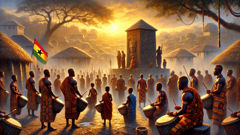
From the sanctuary of the Asafo shrine—a place ringed by carved ancestral stools and guardian stones—drums began to thunder. The rhythm was unmistakable: nkoso, nkoso, nkoso—"advance, advance, advance." Each Asafo group answered with its own cadence, drums echoing across valleys and inlets. Men from the fishing clans came with nets slung over their shoulders, while hunters brought spears and amulets. The women of the village were not silent spectators. They prepared medicinal herbs, dressed wounds, and sang war songs that wove courage into the blood of every fighter. In the shadow of their mothers’ ululations, boys became men and the old remembered their youth.
The Asafo companies were more than fighters. Each one was a living institution—Company One, led by the proud Ebusua family, boasted the most famous flag: a crocodile with a man in its jaws, symbolizing the need for cunning in battle. Company Four’s banner showed two swords crossed behind a hornbill—wisdom and strength united. These flags were not mere decoration. They were passports to memory, reminders of victories and betrayals, of ancestors who had died defending the land. To march beneath one’s Asafo flag was to pledge your life to your people’s safety.
In those tense days, the Asafo prepared for more than violence. They cleaned sacred paths and rebuilt shrines. The annual Akwanbo festival was approaching—a time when the warriors would parade through every street, cleansing away evil spirits and invoking the blessings of Nana Nyankopon, the Sky God. At dusk, bonfires flickered and elders told stories of times when the Portuguese arrived with muskets, when rival Akan kingdoms marched against the Fante, and when Asafo cunning outwitted every enemy. Children listened wide-eyed, learning that bravery was never just about muscle or arms; it was about unity—moving as one, acting for all.
Flags Like Fire: The Battle for the Heartland
The day the raiders came, it was not with a thunderclap but with whispers. A runner arrived before midday, breathless and wild-eyed, clutching a broken arrow as proof. "They come from the east," he gasped, "riding fast, bringing death." The Asafo sprang into action. Their captains—Obrafo Kweku, Adjei the Unbending, and wise old Nana Esi—moved with a calm honed by years of drill. "We fight not for glory, but for tomorrow’s children," Nana Esi reminded her warriors. "Our flags must return unbroken."

The flags were unfurled and held aloft, snapping in the salt wind. The Company One flag led the charge, its crocodile jaws open in defiance. Company Two’s flag showed a chained panther—once captured, now released. Drummers set the cadence as Asafo warriors poured from every alley, faces painted with streaks of indigo and ochre. Spears glinted, and swords flashed in practiced hands. The women formed a rear guard, ready to tend the wounded or bring water as needed. Even the children played their part, scattering palm fronds to slow enemy horses.
The battle that followed was chaos and poetry. Asafo warriors fought in swirling formations, moving as one body. When an enemy force broke through, it was Company Four’s hornbill flag that rallied the defense—its bearer, young Kojo Afriyie, stood tall even as arrows whistled past his head. Old Nana Esi, though frail, led chants that echoed over the fighting: "Aboakye, Aboakye!"—"Warriors, be brave!" There was no room for fear beneath those colors.
When dusk fell, the invaders retreated, leaving behind broken weapons and bitter curses. The Asafo had held the line. Their banners were streaked with dust and blood, but none had fallen. That night, the village became a tapestry of joy and grief. Mothers wept for sons lost, but everywhere, there was pride. The flags were cleaned and paraded through the streets to the slow beat of victory drums. For generations after, stories would be told of the day the Asafo banners burned brighter than any flame.
The Sacred Akwanbo: Renewal and Remembrance
Long after the battle’s scars faded, the Asafo’s true power was revealed not just in war, but in the rituals that bound their world together. Each year, as the harmattan winds swept from the north and the rains gave way to sun, the Fante towns prepared for the sacred Akwanbo festival—the ‘clearing of the path.’ It was more than a holiday; it was a living covenant between the living and the ancestors, a promise that each generation would honor the old ways and protect the new.
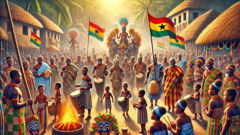
Preparations began at dawn. Asafo warriors, dressed in cloths patterned with company symbols, visited every crossroad and threshold. With brooms made of palm fronds, they swept away dust and lingering shadows. At the edge of the town, drummers gathered, their rhythms rising with the morning sun. Children followed in giddy processions, learning the dances that would one day be theirs. Women arranged flowers at shrines, poured libations of palm wine, and sang songs of remembrance—each note weaving past and present together.
Central to the festival was the parade of flags. Each Asafo company’s banner was carried high through winding lanes: crocodile and panther, hornbill and sword, each one telling its own legend. As the warriors marched, elders recited histories—how Company Three had once rescued captives from a rival kingdom, how Company Five’s cunning had outwitted foreign merchants. The flags danced above the crowd, their colors dazzling in the sunlight. Spectators reached out to touch them, whispering prayers for courage and blessing.
The climax of Akwanbo was the grand assembly in the village square. Here, all Asafo met—warriors, elders, women, children—and together they renewed their vows to the ancestors. Drummers played the forbidden rhythms that called spirits from the earth. Priests poured libations upon sacred stones, and young initiates took oaths beneath the fluttering banners. Even strangers were welcomed into the circle, for on this day, all were Fante—united by song, by dance, and by shared memory.
As night fell, bonfires lit the sky and masked dancers spun in wild arcs. The flags were carefully folded and placed upon the shrine steps, a promise kept for another year. In their wake, the Asafo left not only footprints, but a path for those yet to come.
Conclusion
The legend of the Asafo endures because it’s woven from threads stronger than time—courage in the face of danger, unity when all else falters, and a faith in tradition that adapts without breaking. To this day, along Ghana’s coast, Asafo flags flutter at festivals and funerals alike, reminding all who see them that the spirit of a people is never truly lost as long as it’s cherished. The rituals may shift, the threats may change, but the heartbeat of the Asafo—drums calling the brave, banners bright against the sky—still echoes through the streets and memories of every Fante child. Their legacy is not just one of defense, but of art, kinship, and the living promise that even small communities can shape the fate of nations when they stand together. In every song, every parade, every painted flag, the Asafo whisper: ‘We are guardians. We remember. We endure.’




